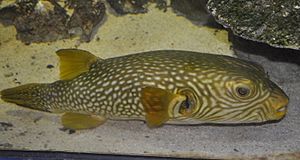Arothron reticularis facts for kids
Quick facts for kids Arothron reticularis |
|
|---|---|
 |
|
| Conservation status | |
| Scientific classification | |
| Synonyms | |
|
Tetraodon reticularis Bloch & Schneider, 1801 |
The Arothron reticularis, also known as the reticulated pufferfish, reticulated blowfish, or reticulated toadfish, is a type of fish. It belongs to the Tetraodontidae family. This fish lives in warm, tropical waters of the Indo-Pacific region. You can find it in places like sandy or muddy seabeds, coral reefs, river mouths (estuaries), and mangrove forests.
Contents
About the Reticulated Pufferfish
The reticulated pufferfish can grow to be about 425 mm (17 in) long. Its body is shaped like an oval and feels soft. It is covered in short, spiky bumps. The area between its eyes is wide and flat. It has small, branched feelers near its nostrils.
Body Features
The line along its side, called the lateral line, is hard to see. It bends sharply above the fin on its underside. Both the top fin (dorsal fin) and the bottom fin (anal fin) are rounded. They each have a few stiff rays (spines) and several soft rays.
Colors and Patterns
This fish is usually brown or dark grey. It has light, round spots on its back, which look like a net. There are also about nine bands of color that go around its body. These bands are alternately dark and light. They start near its snout and curve around its eye, mouth, and the base of its side fins. You can see a large dark spot on its gill cover and another on the base of its side fin. Its tail fin has spots, and its other fins are a clear yellowish-brown color.
Where They Live and Their Homes
The reticulated pufferfish lives in the western part of the Indo-Pacific region. Its home stretches from the east coast of India to southern Japan. It also lives south to Australia and east to Samoa.
Habitats
You can find these fish in the sea, in river mouths (estuaries), and in slightly salty water. They usually live in waters up to about 20 m (66 ft) deep. Good places for them to live include coral reefs that are close to sandy areas or places with seaweed. They also like sandy areas, seagrass meadows, and mangrove forests. Young pufferfish are often found among mangroves. Sometimes, they even swim into the lower parts of streams.
How Pufferfish Behave
Pufferfish are known for being slow swimmers. They have a special way to protect themselves from danger. When they feel threatened, they quickly swallow water. This makes their stomach fill up and their body puff up to a much bigger size. When they are inflated, their short spines stick out, making them look even more intimidating.
Defense Mechanisms
Besides puffing up, these fish also create harmful substances in their skin, reproductive organs, and liver. These substances include tetrodotoxin and saxitoxin, which are very poisonous. During the day, you might sometimes see this fish resting quietly on the muddy seabed.
Conservation Status
The reticulated pufferfish is quite common in many areas where it lives. People do collect some of these fish for aquariums. However, experts do not think this activity greatly harms the overall number of pufferfish in the wild.
Future Concerns
Even though the fish itself is common, the places where it lives are facing problems. Coral reefs, seagrass beds, and mangrove swamps are being damaged. This could affect the pufferfish populations in the future. Some areas where these fish live are protected marine zones. The International Union for the Conservation of Nature (IUCN) has looked at the status of the reticulated pufferfish. They have listed it as a "least concern" species. This means it is not currently at high risk of disappearing.
See also
 In Spanish: Arothron reticularis para niños
In Spanish: Arothron reticularis para niños


